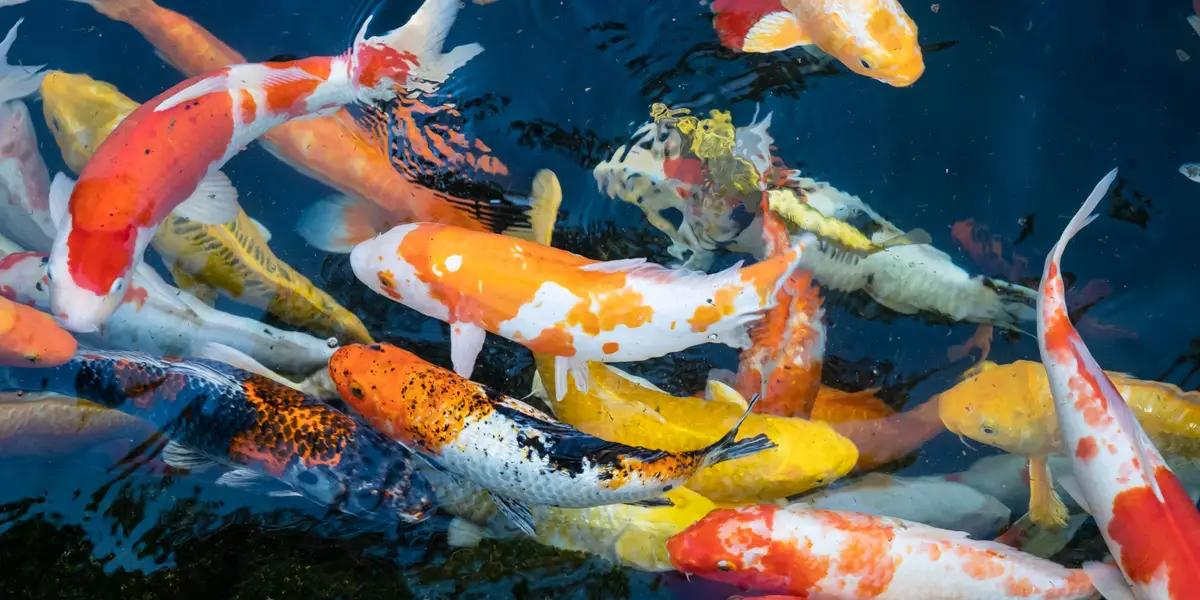Being able to raise your own koi is an unrivalled advantage. There are specific instructions for how to carry out this enjoyable endeavor. Baby Koi Fish are easy to raise with the correct conditions, time, and knowledge.
Even while koi breeding has the potential to be a lucrative enterprise, novice breeders should focus on having fun. What first-time koi owners need to know to maintain their fish healthy and breeding successfully in a garden pond?
Koi Fish Diet: What Can You Feed Them
Koi can eat almost anything humans can. What Do Koi Fish Eat? Shrimp, fruits, vegetables, and anything else with a low carbohydrate content fall into this category.
Fish have a hard time digesting things like bread and comparable items. Fish meal pellets can also be fed to them. Make sure they are the right size.
What do Koi Fish eat? Is best answered by premium food. Fish food for ponds should contain fewer processed ingredients.
When Does The Season Begin To Breed Koi Fish
Koi have more babies at warmer temperatures. The “season” might vary by country, state, and even fish. Most locales breed koi fish outside when the water reaches 68 degrees Fahrenheit. Discover when locals breed. Local koi keepers undoubtedly know this.
- Healthy fish should be at least three years old, and females should be five to eight years old (males have no age limit).
- Keep the breeding tank one foot under water. Add equip, female, and spawning brushes.
- Provide her spring-like conditions. If the tanks are outdoors or well-lit, daylight can aid. Timer controls artificial lighting.
- When ready, the female will search for a nesting location (like the spawning mats). The male is placed in the breeding tank and covered with netting.
What Happens During The Breeding Cycle Of Koi Fish
Experienced breeders pair koi in the evening since it takes a few hours to fall in love. Spawning is best before sunrise. Be close to prevent violence. Koi Fish males grow noisy during courtship, but sometimes they must be removed to protect the ladies.
- When ready, the female sends the male a pheromone.
- He shows her breeding areas.
- The female deposits eggs and the male spits sperm in the initial reproduction stage.
- This natural culling is nutritious, and the parents eat some eggs.
- Until the female no longer sheds eggs.
- Before he gorges, remove him.
The Average Koi Fish Lifespan
A Koi Fish can live anywhere from 15 to 20 years when left to its own devices in the wild. The opposite is true in captivity, where they can live for up to 40 years.
“There are those that can survive up to 200 years,” stated a speaker at the 2016 International Conference on Application for Technology of Information and Communication.
According to records, the Koi Hankou was the oldest koi fish in existence. Koi Hanako, who died on July 7, 1977 at the age of 226, was one of the oldest people in history. The year of her birth, 1751, is credited as being significant.
As she passed away, Hanako held the record for the longest life span of any freshwater koi fish.
Koi Fish Diet
Flakes, the smallest kind of fish food, are the preferred choice of young and juvenile koi. Larger koi like Koi Fish meal bars, whereas smaller koi do well on pellets.
The majority are rich in protein, low in fat, and high in essential elements. Worms, larvae, tadpoles, shrimp, and clams are just a few examples of insects that are commonly eaten.
How Long Do Koi Fish Live
Koi, given the right care and surroundings, can live for 25-50 years on average. There have been reports of koi living to be 100-200 years old, and the oldest koi on record was 226 years old.
The lifespan of a Koi Fish can be increased by providing it with optimal water quality, pond conditions, nutrition, and preventative health treatment.
Complete and balanced nutrition can be provided by the different commercial koi fish meals available to pet owners. The potential health risks associated with overfeeding are a major source of worry.
With the right veterinary care, koi can live much longer. Choose a vet who specializes in fish care, as not all of them will treat your pet.
Koi Predators And Prey
Sadly, Koi Fish are easy prey due to their flashy coloration, which attracts predators. Wading birds like egrets, storks, and herons, as well as small carnivores like raccoons, foxes, and cats, fall under this category.
Because of this, koi ponds should be kept at a depth where a wading bird couldn’t possibly stand. A carnivore shouldn’t be able to reach into the fish’s habitat and grab one by the overhangs, like a low bridge.
It also needs some shading. Because of this, the koi are shielded from the sun and are safe from predatory birds and other dangers.
Koi In Fishing And Cooking
Koi Fish are not caught for food, prepared as food, or kept as pets; they are merely ornamental. As a result of their longevity, some of these items become treasured relics for generations to come.
Its predecessor, the Amur carp, on the other hand, was farmed for human consumption. When genetic abnormalities led to the development of patchy coloration in some carp’s scales, the species began to be bred for its aesthetic value.
Where Are Koi Found
Although Koi Fish may be found in many different environments with access to fresh water, their origins can be traced back to Japan, where farmers began selectively breeding them for their vibrant colors.
Why Are Koi Fish So Special
The distinctive attractiveness of a Koi Fish is the result of its chubby, torpedo-like body and vibrant coloring. Both their lifespan and intelligence are exceptional. They learn to associate their food with specific persons and will eat from your hand.
